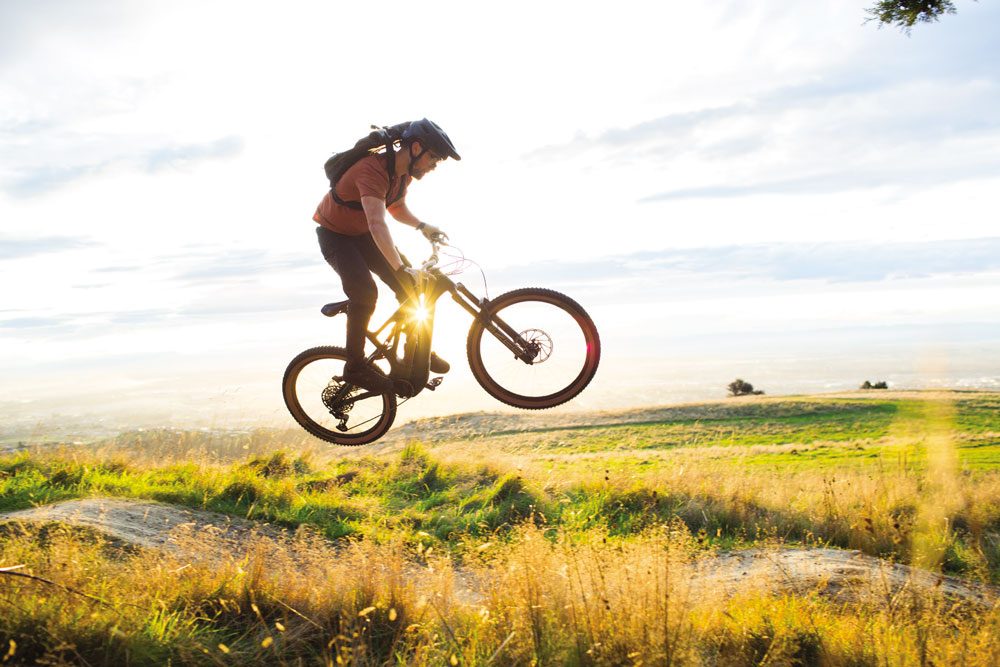Beer Guide Issue 108
‘No alcohol’ is the boom category at the moment, and New Zealand craft breweries make some of the best non-alcoholic beverages in the world.
You’re reading a mountain biking magazine. You love being fit and getting the most out of your body and being in the outdoors.
That makes you a target audience for “lifestyle” beers — which means low and no alcohol, low carb and gluten-free options.
These are sometimes called “better for you” options. And the good news is that “better for you” also means better tasting these days.
Let’s go through some recommendations in all these categories.
THE HEROES OF ZEROES
‘No alcohol’ is the boom category at the moment. I can put my hand on my heart and tell you that New Zealand craft breweries make some of the best non-alcoholic beverages in the world. Believe me, I’ve tried everything on offer.
It’s fair to say imported beers never taste as good as they would if you bought them in the country of origin. “Beer should be drunk in the shadow of the brewery”, is a phrase that still holds true because travel of any kind takes the edge off even the best beer. That’s even more so for non-alcoholic beverages because alcohol is a preservative and therefore, a zero-alcohol beer is not going to travel anywhere near as well as something with alcohol in it, so I’d avoid imported beers in this category.
It’s worth nothing that the legal definition on non-alcoholic in New Zealand is less than 1.15 per cent ABV, which seems high by world standards. While that’s the legal benchmark, most breweries work to the accepted guideline of less than 0.5 per cent ABV.
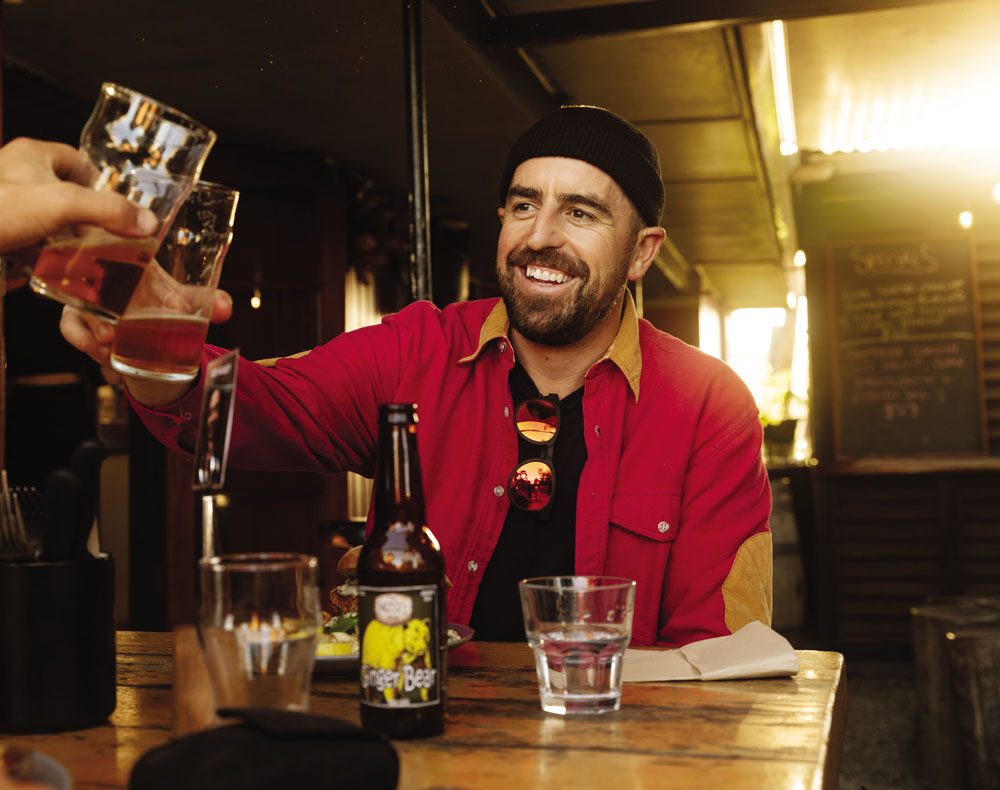
Bach All Day Hazy IPA
Bach created the breakthrough non-alc craft beer with their All Day IPA and this hazy version is a step up from that. Stick with the original if you like clear beer, but this hazy has heaps more flavour.
Garage Project Tiny
Almost a cult beer now because it’s from Garage Project. Lightly lemony hoppy.
Brothers Beer Fill Yer Boots
Another hazy (and as a rule hazies work really well in this category because of the fatter mouthfeel). This has a nice tang of grassy bitterness.
Good George Virtual Reality
A superb offering from Good George. Up there with Garage Project and Bach.
Sawmill Bare Beer
The one non-alc pale ale in this line-up and the only one in a bottle. This has a bite more bitterness than the hazies.
LOW CARB ULTRA TRENDY
While non-alcoholic beers are trending, there’s nothing growing as fast as low-carb beers.
There are many reasons to choose a low carb beer — it could be that you’re on a ketogenic diet, or just trying to reduce the carbohydrate you consume. Or it could be for more important reasons, such as having Type 1 diabetes.
Beers labelled “low carb” have been tested and should come with nutritional panel telling you how many carbs per 100ml they contain. A good guideline is that a low carb beer should have 1-2g of carbohydrate per 100ml.
It’s important to note that low carb does not equal low calorie, though in the case of the beers listed here, some are definitely lower in calories as well. A beer’s ABV (alcohol by volume) will play a big part in the total calories as alcohol sits somewhere between carbohydrate and fat in its calorie density. So, if cutting calories is your thing, do check the labels.
The best thing about modern low carb beers is that they are super- flavoursome. Brewers use a special enzyme, naturally found in malt, to help ferment out any residual sugars.
That has a number of effects on the beer. First, the lack of residual sugar means the beer doesn’t feel as heavy in your mouth. In fact, low carb beers are often very light-bodied and quaffable. Second, low carb beers finish very dry compared with normal beers, which many drinkers prefer anyway.
Low carb pale ales and IPAs are a great place to start if you’re after flavoursome low carb beers. That because the extra hop additions add both mouthfeel, through hop oils, and added flavour. Plus fruity varieties of hops can add a perception of sweetness that covers up the lack of sugar.
Epic Blue Pale Ale
4.8%, Carbs 1g/100ml As you’d expect from Epic, it has great hop flavour — juicy and citrusy — that’s well integrated into the light body. It’s so good for a low carb beer that it made it into the New World Beer & Cider Awards Top-30 on its merits as a pale ale, that’s how tasty it is.
Deep Creek LoCal IPA
3.5% ABV, Carbs 2g/100ml A super low ABV beer compared to others in the range, but you’d struggle to pick it. Brilliantly executed in terms of balance and flavour. A gold medal winner at the 2022 Australian International Beer Awards. Very low calorie count to boot.
Urbanaut Miami Brut Lager
5%, Carbs 1.5g/100ml Packed to the seams with sweet passionfruit and lime hop flavours. A sparkling carbonation and punchy hops on a light and airy body. You won’t pick it as low carb. Urbanaut’s Copacabana IPA is also officially low carb now and is one of the best beers on the market, full-stop.
Emerson’s Super Quench
Pacific Pilsner 4%, Carbs 1.9g/100ml Super pretty beer to look at and, frankly, delicious. Hoppy, refreshing and spritzy light without any soda water notes.
Bach Brut Ultra IPA
4.4%, Carbs 1.7g/100ml Super-fruity with aroma and hop flavour rolling out of the glass thanks to a massive dry-hop bill that features all your favourites: Citra, Mosaic, Riwaka, and Rakau.
LIGHT BEERS ON THE RISE
We don’t use the term “light” the way Americans do to reference their very pale lagers. Here, light means low alcohol — generally regarded as anything below 2.5 percent.
The range of beers in this category is more expansive than in the zero and low carb range, as that little bit of ABV helps create a canvas for flavour.
North End Petit Luna
A clever little beer. Hibiscus brings some fruity character and a lovely pink colour. Kaffir lime coupled with spicy Belgian yeast does some heavy lifting when it comes to flavour. Slightly tart and spritzy.
Sunshine Light Pilsner
Smells like the real deal and tastes great too. The body, naturally, is a little shallow, but shallow can be good: like standing knee deep in the ocean and having the waves splash around your legs. A hoppy aftertaste, with a broad bitterness.
Croucher Low Rider Small IPA
Probably New Zealand’s most celebrated low-alcohol beer. In many ways, it’s almost become the flagship beer for Rotorua’s Croucher Brewing — a remarkable feat for such a low ABV product. It’s changed and evolved over the years into an almost perfect distillation of all the best aromas and flavours of an IPA.
Townshend Half Mast
Typically, of Townshend beers, this is all about balance and the fruity expressive hops are perfectly restrained to match the 2.2 percent base. A wee gem.
8 Wired Lo-Fi
This hoppy sour is sharp as a tack with pinging citrus and light acidity it packs way more flavour that should be feasible at 2 percent ABV.
GLUTEN FREE
It used to be that gluten free was a dirty word in beer (in short they tasted foul) but Upper Hutt’s Kereru Brewing have changed the game dramatically. They are unrivalled when it comes to gluten free beer.
Their Hazee, a gluten-free hazy pale ale, has to be tried to be believed. It’s as good as a normal hazy pale and you don’t even notice the gluten-free aspect. They have a standard gluten-free APA, nice and hoppy, and a clever raspberry-infused version of their original Auro, a golden ale. And they’ve just released a gluten-free Mocha Porter. You can order a mixed box of the gluten-free beers from their website.
Words: Michael Donaldson
Photography: Henry Jaine.
Musings Issue 108
Words and illustration by Gaz Sullivan
“Leaving the power setting on high makes me feel both good and bad at the same time.”
Elsewhere in this very magazine, I wrote a piece about my time aboard the Trek EXe, my first extended period atop an electric-assist machine. I finished by saying: “when I get one”.
Going trail riding on the e-bike is ridiculous fun. The e-assist provides the buzz of riding a mountain bike fast, almost anywhere. The speed available on a flattish trail makes the chore of climbing to the top of a downhill run almost unnecessary. And of course, if you do want a downhill run or three, they are easier to get to.
Surely that is what we look for when we go mountain biking?
It is hard to express exactly why we ride. Sometimes it is for that endorphin payoff available when a difficult task is performed as well as we can do it. Everybody has their own little envelope of bike riding ability and being out there in the woods doing your best is part of why we go out. The desire to do that more often, to make more of your bike time inhabiting that zone, is what has driven the whole phenomenon of shuttling, and for that matter, adding electricity.

A pile of watts that can’t be delivered personally gets us more of that sweet spot we look for.
Well, maybe.
Meanwhile, the Luddite in me has been quietly niggling away in the back of my mind.
I really like the simplicity of basic bikes. I like steel frames, five of the six rideable bikes in my stable are ferrous. I like bikes I can work on myself, which means they have to be simple. I can dismantle and reassemble any of my steel bikes without needing assistance or therapy afterwards.
My carbon, fully-suspended mountain bike with hydraulic brakes and tubeless tyres is bristling with things I don’t feel qualified to mess around with. Yes, I know, these are personal shortcomings I could address, but adding electronics, several batteries and a motor won’t help.
I like going out on my bike with no fixed plan, and riding until I can’t. Having a digital readout on the top tube telling me how much range I have left is a different experience. After a dozen rides I have figured out how much of the battery is required to get me up various hills, in various power modes. Because I know my patch pretty well, I can wring the thing dry most rides. I took great pleasure in arriving home with the readout showing less than ten percent. Several times it was two, and on one occasion, one. How that would work out in unknown territory is something I have yet to experience.
Part of bike riding is also sort of masochistic. People say that getting fitter doesn’t make things easier, just faster. I like to feel how I feel… hard to explain to the outsider but getting to a particular part of a certain ride and feeling slightly less discomfort than the previous episode in that place is a good thing. Adding an external power source doesn’t remove that possibility, but it makes it harder to judge.
Maybe that is the niggling thought I have. When I am on the E, hooning up the climbing section of the jungle trail that is my favourite five kilometres in our local patch, the most accurate description of what I am feeling is probably guilt.
Like, this should be harder. I can make it harder, by buttoning down the power. But I don’t, because the power is what makes this section with the diagonal roots across the trail so much fun.
And leaving the power setting on high makes me feel both good and bad at the same time.
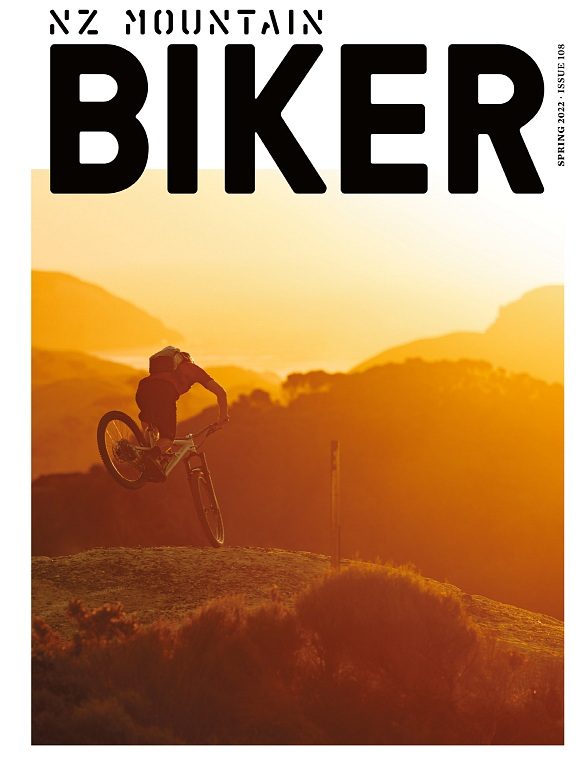
The kitchen: Rice Cakes
Words: Liam Friary
Yes, these are rice cakes. They are a super simple staple that will keep you fuelled during long days on the bike. Bonus — they are easily made ahead and carried on a ride. This recipe is just a starting point; depending on preferences, what foods are in season and what’s available in your pantry, additions can be made. Add anything from maple and bacon to blueberries and chunks of dark chocolate. Get creative with what you like and what you have on hand, wherever it is you’re cooking and riding.
Ingredients –
4 cups tap water
2 ¼ cups white short grain rice
2 ½ cups full fat cream cheese
2 Tablespoons granulated white sugar
2 Tablespoons melted coconut oil
1 teaspoon vanilla extract
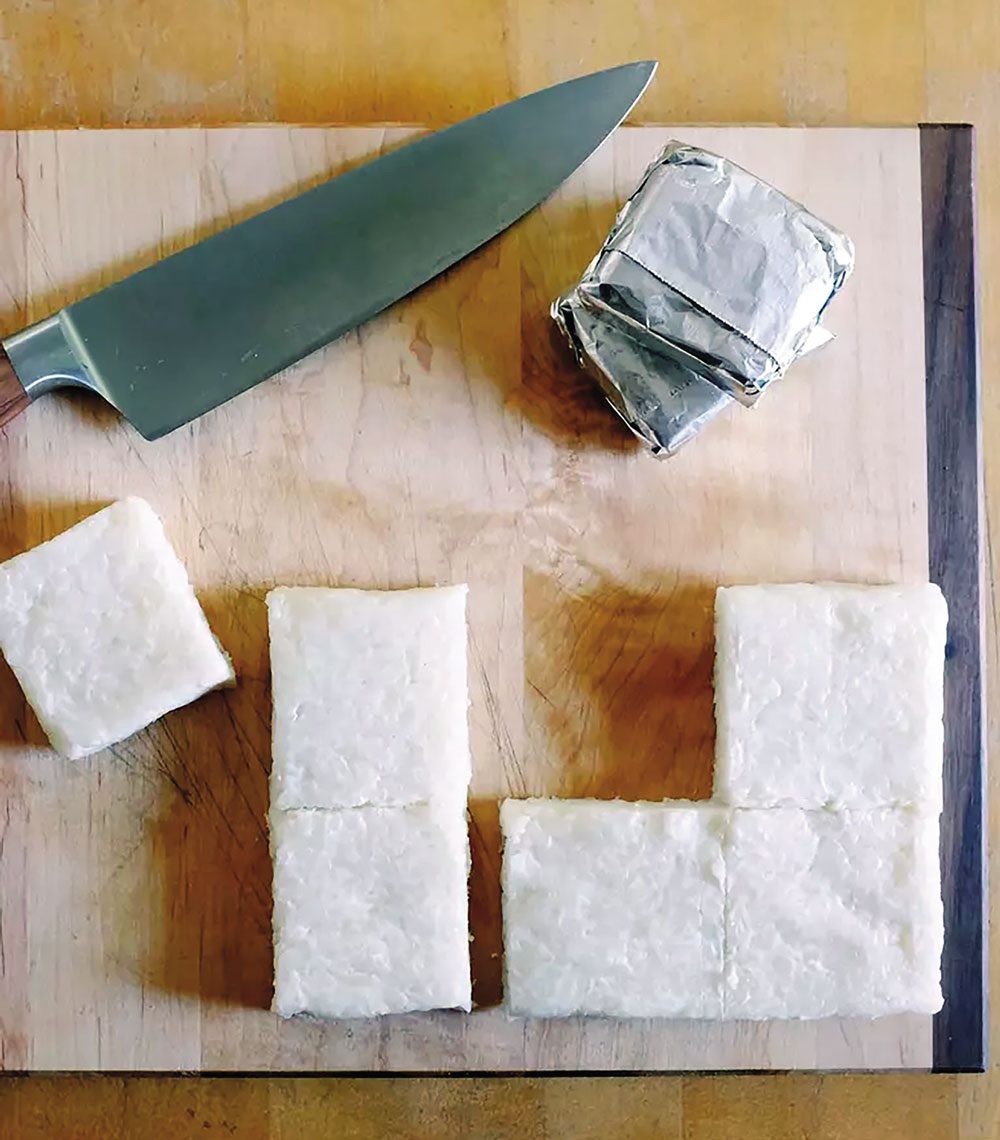
Method –
- In a rice cooker, combine your water, rice, sugar, and coconut oil. Turn it on (white rice setting, if your rice cooker specifies) and let cook. Once cooked, mix cream cheese and vanilla into rice. Note: this is also the time to throw in any spices, fruit, chocolate, nuts, etc that you’d like to add to your rice cake.
- Spoon into a large zip-closure freezer bag. Flatten, smooth the air out and leave to cool on a flat tray. Once cool, transfer to the refrigerator to chill overnight. In the morning, slide your tasty slab of rice onto a cutting board. Cut into approximately 20 squares. You can either keep them all together in an airtight container, or individually wrap them in foil. Either way, they should be stored in the fridge until needed. Refrigerated, they will keep for about four days.

Trail Builder: The Gift That Keeps Giving
Words: Meagan Robertson
Photography: Specialized
Thanks to its Soil Searching initiative — created to recognise, celebrate and support trail builders — Specialized has helped enable future trail building efforts through one local legend and a generous Trail Fund donation.
Talk about making the most of winter — while some hung up their bikes to avoid battering sloppy trails, and others jetted off for an overdue overseas trip, Specialized set its sights on finding and rewarding the nation’s top trail builder with a limited edition Soil Searching Specialized Levo, then auctioning off a second and donating all the proceeds — an incredible $17, 850! — to Trail Fund NZ.
BUILT FOR TRAIL BUILDERS
Designed for trail building, and to reward trail builders, the Mountain Guardian is one of 50 Soil Searching Specialized Levos produced worldwide. Featuring the Specialized Soil Searching logo to reiterate the importance of trail building while following sustainable building practices, the custom made eBike boasts Soil Searching Paint, RockShox Zeb Select + Fork, RockShox Super Deluxe Select + Shock, SRAM XO1 Groupset, Code RS Brakes, Soil Searching Tyres, Roval Traverse Alloy Wheels and TCU2 Display.
In mid-July, Specialized put the call out to ensure one of the two Mountain Guardians in New Zealand landed in the hands of New Zealand’s best trail builder. In a country known for its incredibly high number of volunteers, the nominations came in hard and fast, with more than 100 committed and talented trail builders in the running.
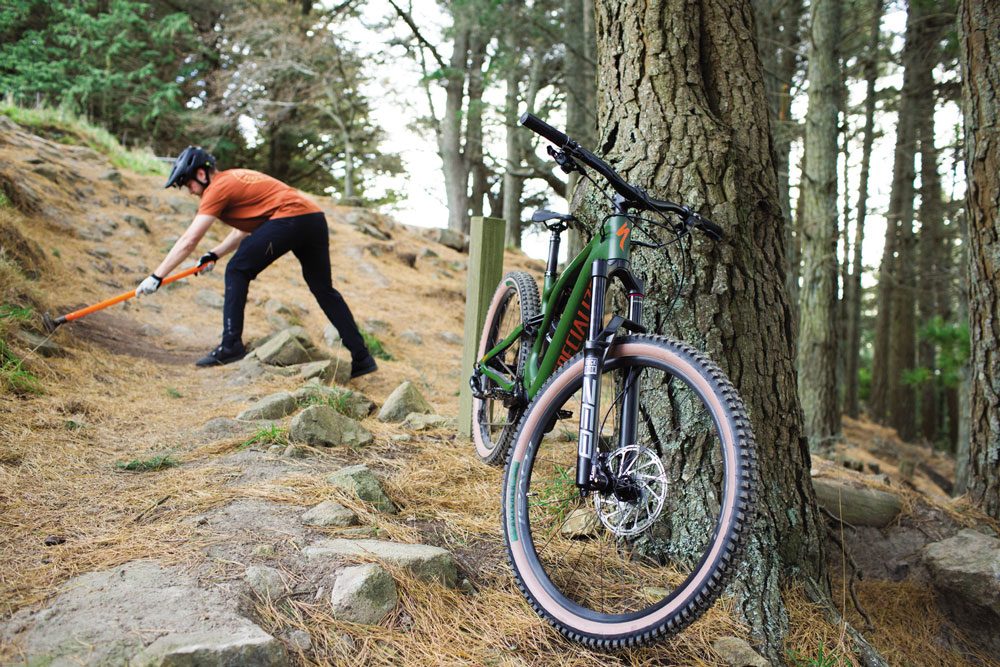
THE REAL DEAL
With only one Mountain Guardian to give, Specialized NZ reviewed every application and, according to Specialized’s Marketing and Events Coordinator, Ben Crowley, choosing the winner was no easy task.
“Trail builders are the unsung heroes of mountain biking, and we are committed to changing that by recognising, celebrating, and supporting the trail builders who help shape our sport and our stoke,” explained Ben.
“That said, there are a lot of them, and so many are volunteering in a way that is truly outstanding that it made the choice incredible difficult. In the end, we decided on a guy that sums up what Soil Searching is all about — Marty Richards.”
A key part of the Cable Bay Adventure Park trail crew based in Nelson, Marty is a trail builder that leads by example.
“Marty is a serial volunteer whose contributions to various projects have improved the trail offerings for all in Nelson and, over the past three years, he has had direct involvement with all of the 18 trails built at Cable Bay,” says Richard Ussher.
“Marty is super approachable and always willing to help or give advice to new trail builders. He never asks for anything, or expects anything in return, and truly does it for the love of mountain biking. He has inspired and imparted a lot of knowledge to a wide group of people, which has helped grow the competence of trail builders in the region.
“Probably the biggest influence he has had is with the ‘Sunday School’ team. This is a group of teenagers from a variety of backgrounds who come out to the Adventure Park to regularly dig and maintain trails with Marty. Nicknamed ‘Dad’ in the group chat due to his mentoring, Marty organises transportation, oversees the trail building and drives shuttles for them afterwards.
“The Sunday School crew often do some of the toughest yards on the sections that others shy away from, and it is easy to see the positive influence impact he has had on them.”
Richard says Marty is so committed to ensuring the best experience for Cable Bay riders that he has — largely by himself — built a 1km walking track for the sole purpose of getting walkers and other non-mountain bike users off the main exit trail at the park.
“It is hard to overstate what a positive member of the mountain bike community he is. He is never looking for recognition and just gets on and does what he loves — digging and riding. The region would undoubtably be significantly poorer without his massive efforts.”
Marty was absolutely thrilled to receive the Mountain Guardian and is already putting it to good use!
“I feel so privileged to know such an awesome group of people and so humbled from the support I’ve received from the Nelson MTB community and Cable Bay Trail Crew,” said Marty.
“It’s been quite overwhelming. I think I’ll go hide in the bush for a bit… and go dig a track.”

Marty Richards.
PAYING IT FORWARD
With one Mountain Guardian out the door, Specialized looked to further support trail building through a different channel — Trail Fund NZ.
“We created Specialized Soil Searching to fuel and support the energy and passion of the trail building community,” says Ben. “So, we thought, what better way to do that than fundraise for an organisation that is already doing that on a regular basis?”
Founded in 2012, Trail Fund NZ is a not-for-profit organisation, run solely by volunteers, supporting the development and maintenance of publicly available, environmentally sensitive and sustainable mountain bike-accessible trails in New Zealand. It is also committed to providing funding for — and education on — trail building, as well as advocating on behalf of mountain bikers to Government.
Since its inception, Trail Fund has distributed more than 150 grants — totaling more than $400,000 — to a wide variety of mountain bike trails. From Thames to Taupo to Wanaka to Bluff, from Grade 5 singletrack to skills parks, Trail Fund has tried to cater for riders of all abilities around the country.
And now, thanks to Specialized donating the proceeds of the second Mountain Guardian to Trail Fund NZ, the organisation can provide even more grants than normal in the coming months.
“We are so thrilled to be able to pass on the money raised by Specialized to trail building groups around the country using our well-established funding process,” says Trail Fund president, Hasely Lobb.
“This is the most substantial donation we have received to date and it’s great to see bike brands investing in the trails their customers love to ride.”
Thanks to the donation, Trail Fund’s next funding round is our biggest in many years, with four grants of up to $4,000 available. The deadline is 1 December. For more details, see the ‘Get Funded’ section on trailfund.org.nz






